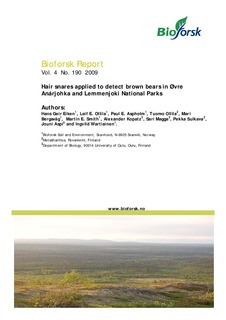| dc.contributor.author | Eiken, Hans Geir | |
| dc.contributor.author | Ollila, Leif E. | |
| dc.contributor.author | Aspholm, Paul Eric | |
| dc.contributor.author | Ollila, Tuomo | |
| dc.contributor.author | Bergsvåg, Mari | |
| dc.contributor.author | Smith, Martin E. | |
| dc.contributor.author | Kopatz, Alexander | |
| dc.contributor.author | Magga, Sari | |
| dc.contributor.author | Sulkava, , Pekka | |
| dc.contributor.author | Aspi, Jouni | |
| dc.contributor.author | Wartiainen, Ingvild | |
| dc.coverage.spatial | Norway, Finland, Finnmark (NO) and Lappland (FI), Kautokeino (NO) and lnari (FI) | nb_NO |
| dc.date.accessioned | 2017-12-01T11:42:43Z | |
| dc.date.available | 2017-12-01T11:42:43Z | |
| dc.date.created | 2017-11-07T14:36:42Z | |
| dc.date.issued | 2009-12-21 | |
| dc.identifier.isbn | 978-82-17-00599-5 | |
| dc.identifier.uri | http://hdl.handle.net/11250/2468776 | |
| dc.description.abstract | There is limited knowledge on the brown bear (Ursus arctos) populations in the neighboring national parks Lemmenjoki in Finland and Øvre Anárjohka in Norway. Lemmenjoki is the largest National Park in Finland with its 2850 km2, while Øvre Anárjohka National Park is about 1390 km2. Studies of the bear population within this area are complicated by the fact that the area is one of the largest roadless and remote areas in Northern Europe. In this study we have applied the hair trap technique to monitor the brown bear populations of Øvre Anárjohka and Lemmenjoki during July and August of 2009.The study was limited to 850 km2 (34 hair traps in a 5 x 5 km grid, 20 % of the total area of the National Parks). The result was a total of 33 hair samples collected in the study period of 8 weeks (4 renewals of scent lure), which is on average 0.5 hair samples per trap/month. DNA from bears was detected in 28 of the samples (85%). We were able to analyze a complete genetic profile for 23 samples. Nine samples from the terrain were also included in the study, and in total we have identified 6 different bears within the study area. The average brown bear density for the study area was found to be 0.07 bears/10 km2, which is 3 times lower than in the neighboring population in Pasvik-Inari-Pechenga. The three bears identified at the Norwegian side of the border (two females and one male) had been previously detected in Øvre Anárjohka in Norway during 2005-2008, while the three males that were solely on the Finnish side had not been registered before. Comparison with previous monitoring data in Norway confirm that Øvre Anárjohka in Norway might be a low-density reproduction site for brown bears, while the study area in Lemmenjoki in Finland is sparsely populated by a few males. We recommend that a larger study should be performed in the area. | nb_NO |
| dc.language.iso | eng | nb_NO |
| dc.publisher | Bioforsk | nb_NO |
| dc.relation.ispartof | Bioforsk Rapport | |
| dc.relation.ispartofseries | Bioforsk rapport;4(190) 2009 | |
| dc.subject | Brunbjørn | nb_NO |
| dc.subject | Brown bear | nb_NO |
| dc.subject | Molekylær økologi | nb_NO |
| dc.subject | Molecular ecology | nb_NO |
| dc.subject | Bestandsovervåking | nb_NO |
| dc.subject | Population monitoring | nb_NO |
| dc.title | Hair snares applied to detect brown bears in Øvre Anárjohka and Lemmenjoki National Parks | nb_NO |
| dc.type | Research report | nb_NO |
| dc.description.version | publishedVersion | nb_NO |
| dc.subject.nsi | VDP::Molekylærbiologi: 473 | nb_NO |
| dc.subject.nsi | VDP::Molecular biology: 473 | nb_NO |
| dc.source.pagenumber | 25 | nb_NO |
| dc.source.volume | 4 | nb_NO |
| dc.source.issue | 190 | nb_NO |
| dc.identifier.cristin | 1511841 | |
| dc.relation.project | Bioforsk: 4310090 | nb_NO |
| cristin.ispublished | true | |
| cristin.fulltext | original | |
